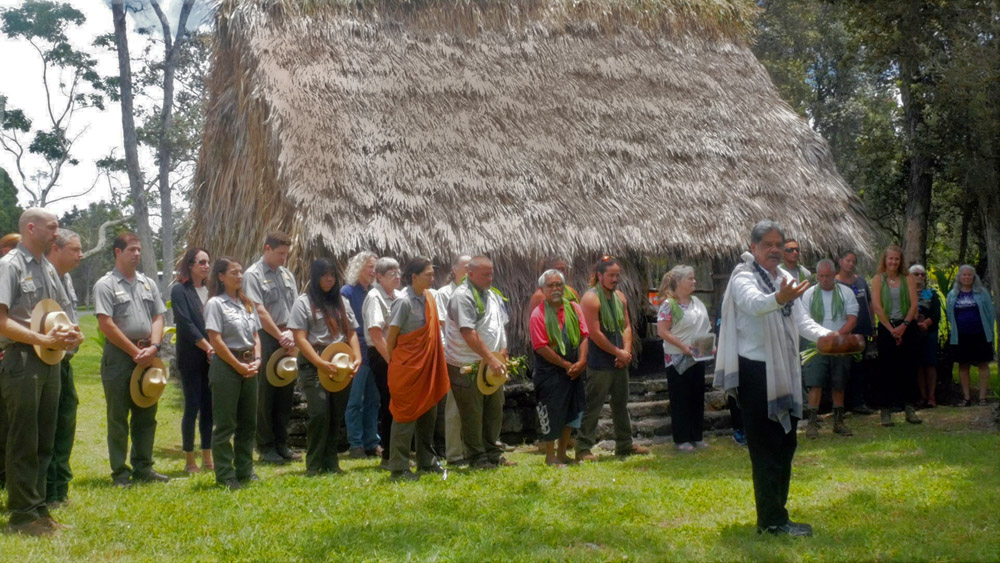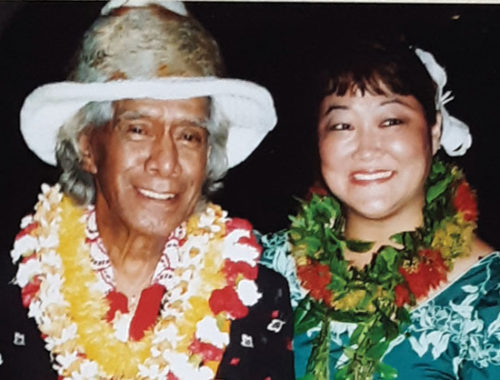World Wide Voyage: Wayfinding Around ‘Island’ Earth, Provisioning the Wa‘a
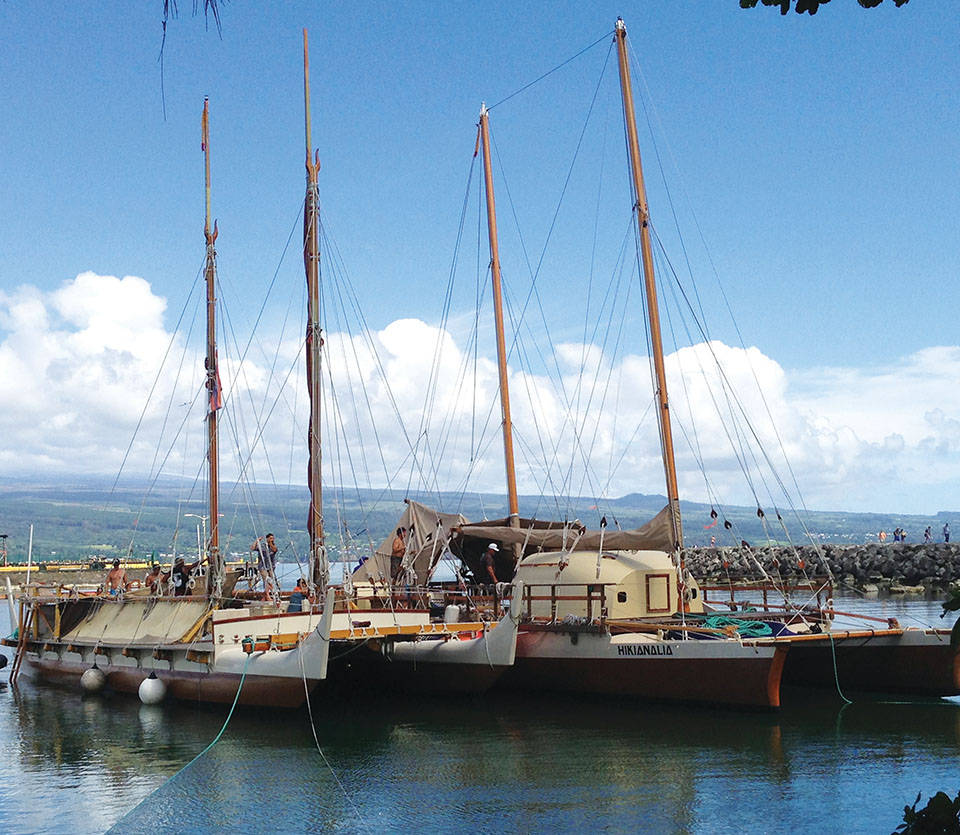 By Margaret Kearns
By Margaret Kearns
E Lauhoe mai na wa‘a; i ke ka, i ka hoe,
i ka hoe, i ke ka; pae aku i ka‘aina.
Everybody paddle the canoes together; bail and paddle,
paddle and bail, and the shore will be reached.
Hawaiian Voyaging Proverb
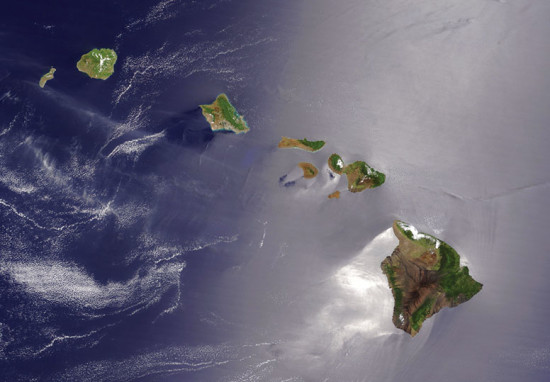
What was sparked by a fleeting glimpse of the Hawaiian Islands from outer space in 1992 is now a dream brought to life by the Polynesian Voyaging Society (PVS) and its many members, crew, volunteers, and sponsors—the Mālama Honua (care for the earth) World Wide Voyage (WWV). The five-year voyage (2012–2017) is being made by highly skilled navigators and crews aboard the two-hulled sailing canoe Hōkūle‘a, an authentic replica of the canoes used by ancient Polynesians on their wayfinding journeys throughout the Pacific centuries ago, including, of course, the Hawaiian Islands.
It was NASA astronaut Lacy Veach (who grew up in the islands) who, while orbiting the earth on space shuttle Columbia, looked out the porthole just in time to view Hawai‘i Island and planet earth in one vision.
“The sight of the islands took my breath away; more than that it gave me the vision that planet earth is an island just like Hawai‘i, an island in an ocean of space,” Lacy said at the time. “My thought was, we need to take care of our islands and the entire planet, if it is to remain a life-giving home for humanity.”
Via satellite phone aboard Columbia, Lacy, who died in 1995, spoke with childhood friend Nainoa Thompson, a leading navigator for the PVS, to immediately share his vision, and the conversations continued at Nainoa’s kitchen table when Lacy returned to earth! Among the topics was concern that Hawai‘i was heading towards an unsustainable future.
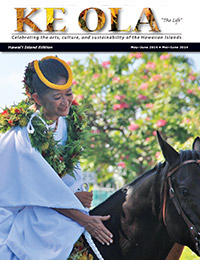
Nainoa’s late father Pinky’s point of view at the time was, “The knowledge and values that served ancient Hawaiians are truly strong and inspirational. They enabled them to care for Hawai‘i and her seas for nearly 2,000 years through the careful management of natural resources to sustain a large, healthy population.”
It was his call for action to Hawaiians and all island residents to re-embrace these core values and traditions, to go out and share them with the world, and to learn from others about what they are doing to mālama their islands, their countries. This seed grew into the WWV with son Nainoa. Nainoa and fellow navigators ‘Onohi (Chadd) Paishon, Kalepa Baybayan, “Shorty” Bertelmann (all from Hawai‘i Island), and Bruce Blankenfeld are navigating the way to a healthy and sustainable future—sharing the aloha and traditions of the Hawaiian culture.
Prior to their departure, Nainoa stated, “As much as possible, throughout our journey around the world, Hōkūle‘a will use non-carbon-based renewable energy, such as wind and sunlight, just as our ancestors did.”
The first leg of Mālama Honua (Mālama Hawai‘i) set sail from Honolulu on April 16, 2013 for an island-wide round-trip tour completed on August 7—more than two decades after that fortuitous glimpse out of Columbia’s porthole!
Weather permitting, the crew will set sail this year from Hilo on May 27, following Hōkūle‘a’s months in dry dock on O‘ahu. From there, Hōkūle‘a continues its five-year journey, setting sail for Tahiti and then on to New Zealand. Her escort boat for this first international leg of the voyage will be her modern day twin, Hikianalia.
Hikianalia is the next generation of long-range wayfinding canoes. According to PVS representatives, the craft is “modern and slick, outfitted with state-of-the-art radar, compasses, ARGOS transponders and a global positioning system (GPS) unit to give the crew information in an emergency.”
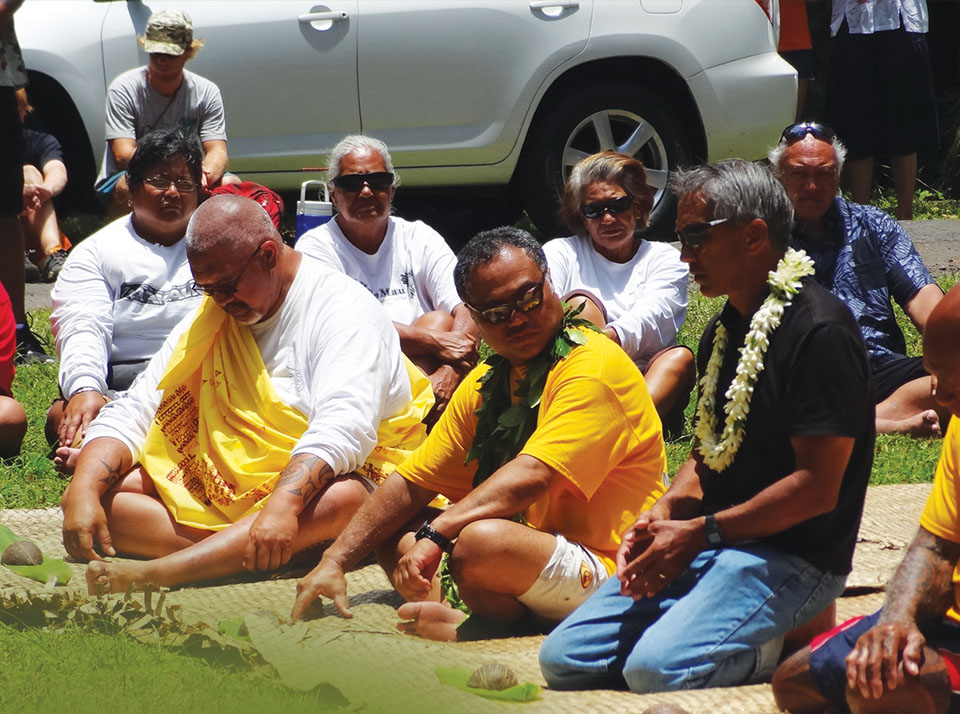
During this WWV segment, Hōkūle‘a will make port in at least 15 different locations, according to Hawai‘i Island artist, lure maker, and long-time contributor to the Voyaging Society, Gary Eoff. He will provide Hōkūle‘a with fishing lures and some of the gifts to be offered at each port.
In addition, a museum-quality exhibit of ancient Hawaiian tools, fish traps, ipu and gourds created by Gary, a long-time Hawai‘i Island resident and curated by internationally acclaimed artist, Hiroki Morinoue, a native of Hōlualoa on Hawai‘i Island, will be carried on the canoe and shown at stops along the voyage. The objects are reproductions of traditional Hawaiian cultural artifacts and were inspired by the expert craftsmanship, high level of aesthetics, and the natural materials used in the culture of old Hawai‘i.
“By rediscovering the traditional practices and skills of our ancestors, we protect the land and ocean resources for our future,” Gary says, aligning with the WWV mission. “Itʻs rewarding to make new things in the old style with the same natural materials.”
All of his materials are gathered in a manner that respects the forests and ocean.
“I am always careful to nurture the plants and help them to reproduce more than what was taken. This is in the same spirit as the original craftsmen and practitioners. None of the materials are from modern sources. Everything from the raw fiber to the plant-based dyes is harvested form the forest or ocean using sustainable methods,” he says.
In keeping with the PVS commitment to education, the WWV is both receiving the assistance of grade school children in helping with provisioning the canoes and giving back to them by providing live broadcasts weekly from Hikianalia to classrooms throughout Hawai‘i on a rotating basis. The broadcasts provide up-to-date news and the current location of the canoes. They also share crew experiences and discoveries along the way, including the foods, culture, and traditions of the places they visit and descriptions and views of the natural environment of that area.
Several Hawai‘i Island schools participated in making cordage that is included in Gary’s round, rope-lashed gourds that are being gifted to officials at each port.
“The cordage, which has been placed inside the gourds, is a metaphor for the purpose of the voyage—that is, binding all humanity together,” he says.
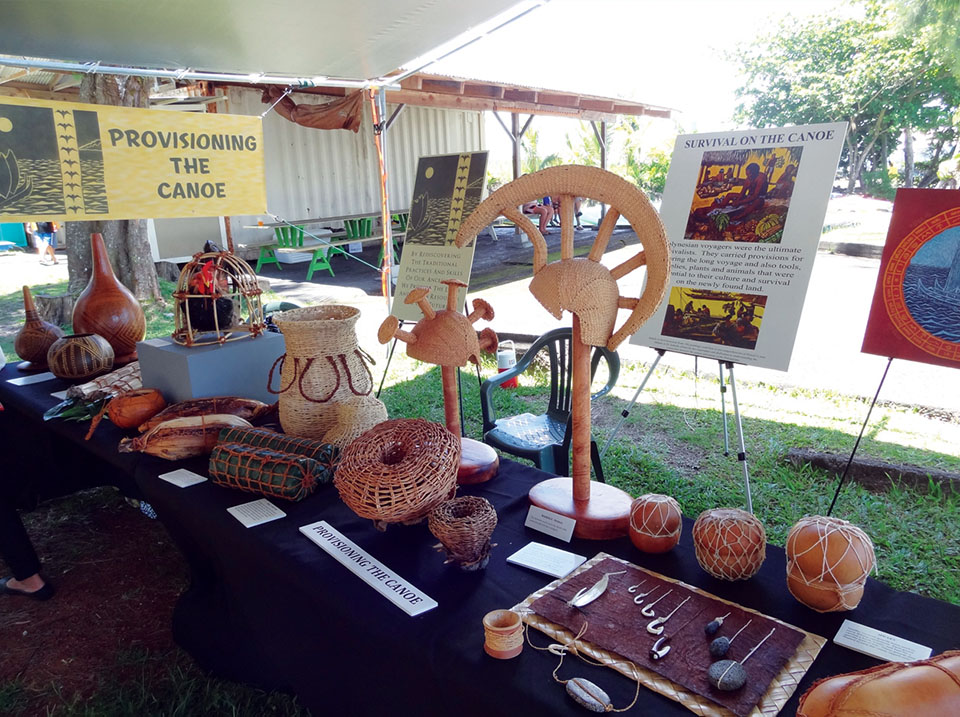
Feeding the Crew
Many of the schools that have sustainable fruit and vegetable gardens are participating in provisioning one of the most important needs of the crew on the voyage: nourishment! Each crew requires a minimum of 3,000 calories a day to maintain peak performance.
The children are learning to grow, harvest, pickle, and dehydrate food for the voyagers, just as the Polynesians fermented and dried foods for their wayfinding voyages centuries ago.
Navigator Chadd came up with the “ ‘Ai pono” (the right or the powerful way to, in this case, nourish) concept during the early planning stages for the WWV.
“We have our waves, we have our hula, we have our canoe, and we have our navigators. Now, it is time to focus on nutrition,” Chadd says.
To accomplish it, Chadd called on his friends and respected nutritionists, Nancy Redfeather and Ka‘iulani Odum, to work with the schools and to develop menus comprised of the “super foods” of old, including fresh sweet potatoes, yams, taro, breadfruit, coconuts, bananas, and sugarcane. These fresh provisions will be replenished at each port of call, while the pickled and fermented foods will sustain the crew in between, they say.
Researcher, writer and waterman Tommy Holmes, a co-founder of PVS, writes in his classic book, The Hawaiian Canoe, published in 1981:
“The Polynesians preserved most of the meals they would need for a long canoe voyage by drying or fermenting either raw or cooked foods.
Compact, light, nutritious and almost spoilage free, the voyagers’ diet would have consisted of fish, turtles and other marine organisms, along with bananas, sweet potatoes, yams, breadfruit, taro, and pandanus flour. Undoubtedly there were trolling lines out all day, every day.
Floating zoos, Polynesian voyaging canoes carried pigs, chickens, and dogs which were intended as breeding stock for a new settlement, though they could also be eaten if stores dipped perilously low. Rats were sometimes uninvited passengers and may have occasionally provided an emergency meal.”
Holmes also notes that through experience, the Polynesians learned there were few edible plants growing on previously uninhabited islands, so together with their floating zoos, provisions included dozens of varieties of plants, fruit trees, and seeds. Slips, cuttings, tubers, and young plants were swathed in fresh water-moistened moss, wrapped in ti leaf, bark cloth (kapa) or skin from the banana tree.
On board, fresh food was cooked in a hearth lined with stone, coral, and sand. Coconut husks and shells provided the fuel for the fire; fresh water was stored in gourds and sections of bamboo, the historian writes.
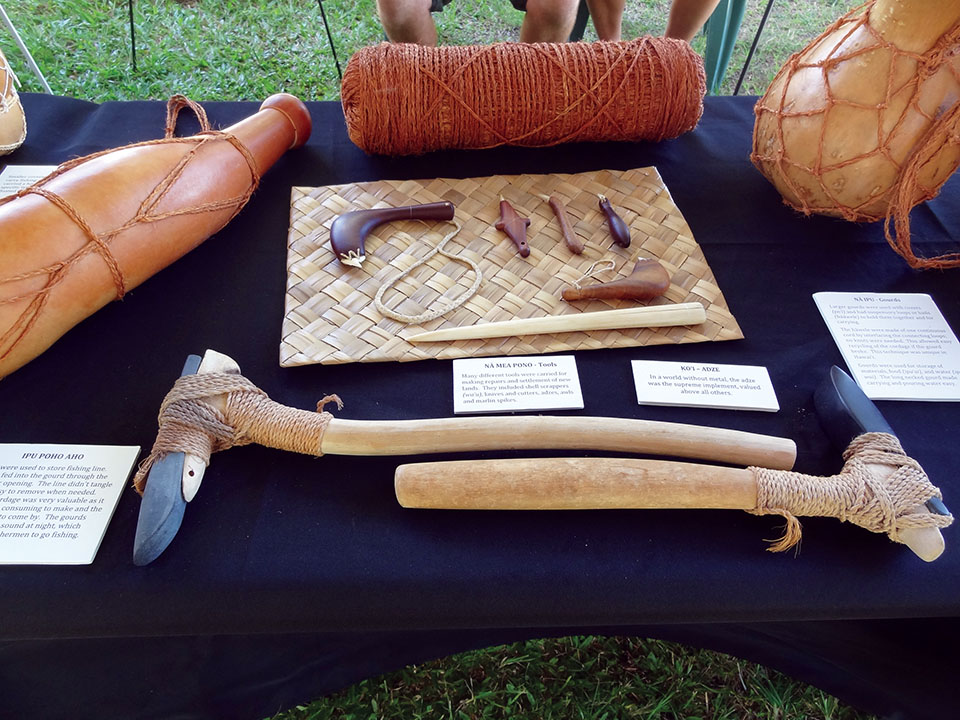
Provisioning in 2014
Today, Hōkūle‘as is a relatively self-contained environment—an island in the sea. Much like the original voyaging canoes, it takes with it what the crew needs to survive for the estimated time at sea during each leg of the voyage and supplements that with the fresh fish and fresh rainwater caught during the trip.
The canoe weighs seven tons (14,000 pounds) with its rigging, and it can carry an additional 5.5 tons (11,000 pounds), which includes the weight of the crew, as well as the weight of provisions, supplies, and personal gear. According to the PVS, the weight allocation breaks down like this:
- About one ton of food,
- 1.75 tons of water stored in five-gallon jugs,
- and the remainder of the allocated weight is comprised of: galley equipment (propane gas stove, pots and pans, kitchen utensils, dishes and glasses); safety equipment (life preservers, safety harnesses, safety nets, fire extinguishers, man-overboard float with pole, surfboard, anchors, hand-operated bilge pumps, foul weather gear, and waterproof flashlights); medical supplies; assorted tools; documentation equipment (cameras, video camera, tape recorders); plus various sizes of sails, extra ropes, and lines.
Perhaps most importantly, the quartermaster must distribute the weight of these supplies in the canoe’s two hulls, being careful not to overload the canoe since this will reduce its maneuverability and increase the possibility of swamping.
Now that the Hōkūle‘a is provisioned, the crew trained, the chants and blessings made to ensure steady winds and smooth seas for a speedy and safe journey beginning in May.
Become Involved
You can be part of the WWV by becoming a PVS member.
“The success of our organization could not be possible without the unwavering support of our members, volunteers, donors, staff, crew and leadership,” Nainoa says. “Whether or not you will sail on a canoe, we invite you to join this historic voyage as a member of the Polynesian Voyaging Society.”
No amount is too small, he emphasizes; for just $1 and completion of the Society’s application form you are a member for one year. ❖
To join Polynesian Voyaging Society: pvs.hawaii.com/about
For info on the World Wide Voyage: Hokulea.org
Contact writer Margaret Kearns: margaretekearns@gmail.com

